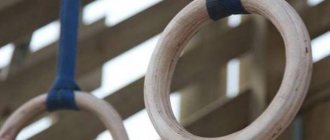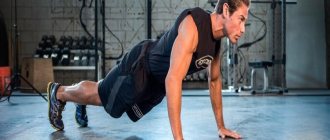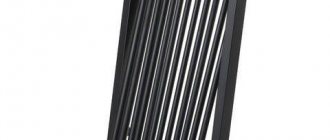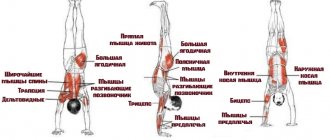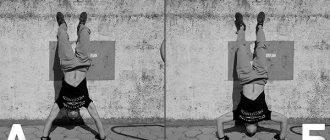Anyone who has seriously decided to take care of their body cannot do without basic knowledge of anatomy. So, in the process of working on muscles, you need to understand that they are formed by two types of fibers - fast and slow, and therefore different exercises give different effects. Fast fibers are relatively easy to build up, they are included in any high-intensity exercise.
Statodynamics in bodybuilding: exercises
The situation is different with slow fibers: their main task is long-term work and providing the body with heat. Therefore, it is more difficult to pump up these fibers during bodybuilding. This requires a special approach, for example, power static dynamics.
Start of classes
In such exercises, you must pay special attention to the first days. Everything must be accurately calculated and a certain schedule must be adhered to. Nutrition is one of the main elements.
Most men and women easily gain excess weight, although there are also people who are not at all susceptible to this influence of food. Without watching their own diet and without doing at least the simplest physical exercises, people gain excess weight quite quickly.
Adipose tissue that forms bulges in the abdominal area does not look very aesthetically pleasing, because it makes the bodies of both men and women loose and unattractive.
Optimal combination of dynamics and statics
Statistical and dynamic exercises must be carried out taking into account their strengths and weaknesses, and the health indicators of the trainee. Most of the sports session should be devoted to active movements. This is especially true for representatives of the fair half of humanity. The recommended proportion of dynamics and statics is 70% - 30%, respectively. For men, the overall training content can be increased by static work from 30 to 40%.
At the initial stage, experts advise not to include statistical exercises in classes at all. This is due to the fact that in an untrained person the tendons and the places where they connect to the bones are poorly developed. In the first two months, it is better to focus on dynamics, partially connecting statics, and gradually increasing it to 30 or 40%. Statistical and dynamic loads in harmony is the secret to successful sports. The dynamics are shown for women, men and even small children. At the same time, in no case should we forget about the role of proper sleep, nutrition and rest. Only in this case can you get all three components: a flexible, toned body, healthy internal organs, vitality and a positive attitude.
Unhealthy food
Many people are confident that their diet is correct, but most often this is not the case. People have no idea which foods will be healthy and which are contraindicated by nutritionists and other doctors.
You should know that sweets, as well as fried and fatty foods are foods with “empty calories”. And foods containing sugar should be eaten only after training, as they restore energy. These carbohydrates are also allowed to be consumed in the morning, and at any other time they will go exclusively into fat.
Therefore, there is no need to blame everything on exercises that do not help get rid of fat. First, you should create the right diet for yourself or ask professionals for help.
Types of exercises
Today there are three types of basic exercises:
- Static.
- Statodynamic exercises.
- Dynamic.
Bodybuilding is a fairly popular activity today. Training programs are available for every beginning athlete. Let's look at the example of a hand expander:
- Statics - the expander is compressed and held for the maximum time.
- Dynamics - the expander compresses and unclenches until complete relaxation.
- Stato-dynamics is practically the same as dynamics, only you don’t need to open the expander all the way.
Dynamics and statics: main differences, advantages and disadvantages
Dynamic training involves moving the body or its individual parts in space. The list of classical dynamics includes jumping, running, push-ups, swings, bending, swimming, cycling and dancing. In the process of performing static exercises, parts of the body are fixed in a certain position for some time. Examples include planks on the palms, toes or elbows, fixing the legs in a standing or lying position, asanas in yoga. Dynamics and statics have a number of advantages and disadvantages. The main advantages of dynamic exercises include:
- intensive increase in muscle mass;
- toned body shape;
- prevention of congestion in the musculoskeletal system;
- activation of metabolism;
- improving the functioning of the cardiovascular, respiratory system, joints.
Pros of static training:
- strengthening the body's defenses;
- stimulation of the removal of toxic substances;
- active saturation of blood with oxygen;
- no need for a large space.
It should be borne in mind that statics do not contribute to external muscle work, and muscle growth cannot be achieved with its help. Some dynamic exercises may be undesirable or prohibited in case of diseases of the musculoskeletal system, diseases of the heart and blood vessels. Dynamic load in some cases requires significant free space or special training equipment.
A set of exercises for runners
As you know, static-dynamic exercises can be very different. For example, a special set of statodynamic exercises specifically for runners is now in first place for many athletes.
- Standing with your toes on a hill, rise and fall below the horizontal (25 lifts on one leg).
- Slow squats on one leg, partial rise (15 times per leg).
- Lying position, legs bent at the knees and raised. You need to raise your head, shoulders, and upper body (60 seconds).
This little facility is perfect for beginning runners. It significantly increases the aerobic properties of fast-twitch muscles.
When and How Much to Do Dynamic Stretching
It all depends on what goals you want to achieve. Perform dynamic stretching before every workout if you want to increase your performance. But don't get carried away: the warm-up shouldn't be Acute Effects of Dynamic Stretching on Muscle Flexibility and Performance: An Analysis of the Current Literature. Otherwise, you may get the opposite effect: your body will become tired and your productivity will decrease.
It is best to combine dynamic stretching with other techniques. For example, you can do joint exercises for 2 minutes, then do 5 minutes of light cardio, and then move on to 5 minutes of dynamic stretching. Choose five or six exercises and perform each of them for 30 seconds. Also try to focus on your weak points.
If you just want to stretch your body in the morning or in the middle of the working day, create a set of 10 exercises and perform each for 30-60 seconds. Choose movements that involve all muscle groups - this will help to warm them up evenly. Change the exercises of the complex periodically to avoid imbalance. And don’t ignore some areas just because you don’t like working them out: the stiffer the muscle, the more it needs stretching and relaxation.
Special program
A hit of our time among bodybuilders are static-dynamic exercises.
At first glance, squats with a barbell do not seem entirely necessary, because they do not affect all muscles. But this is not at all true. In fact, this type of squat works a large number of muscle fibers.
Typically a person feels tired within 35 seconds of doing it. In order to endure a little longer, you should take a little less weight. We must not forget that the pace is very slow when performing static-dynamic exercises, so here, more than ever, endurance will be required. You should set certain boundaries for yourself while squatting so as not to cross the line and prevent your muscles from relaxing.
Professionals advise performing squats with a barbell in the form of super series. That is, the exercise lasts about 40 seconds, then rest for the same time, and repeat all this three times. This is followed by a 10-minute rest. In total you need to make 4 super series.
These exercises help well with illnesses and also perfectly correct the figure.
bodybuilding and fitness | www.iron-addicts.com
View training programs
Statodynamic exercises
Statodynamics is a technique in which the exercise is performed with constant tension, statodynamic exercises on muscles and a small amplitude, slowly, for 40–50 seconds, which leads to acidification of the muscle, the failure should be an unbearable burning sensation. The number of repetitions is 15-25. To achieve a feeling of unbearable burning, you can pause the movement for 5-10 seconds at the moment of peak contraction, which will cause a static-dynamic training reaction, namely acidification of the muscle fibers. Statodynamics can be used for strength training, but it is of little use for hypertrophy and drying since it activates mainly slow muscle fibers (SMF).
Statodynamic exercises
Technique using the example of squats. Having squatted down to a right angle with the floor or any surface, we begin to slowly perform up and down movements with a small amplitude (10-15 degrees). Those. Having stood up a little, we slowly lower ourselves to a right angle and without a pause we rise up again. So you need to perform the movement for 30-60 seconds, keeping the muscles in constant tension. If nothing happens, then after a 30-second rest, repeat the approach. And so on until a burning sensation develops.
Training programs for fat loss | 100% working programs!
Efficiency mark
Initially, Silyanov’s statodynamic exercises were recommended for the development of strength and aerobic capacity, but comparative assessments with the classical technique were not carried out. It should be noted that Seluyanov is not the author of this approach, but only popularized it in Russia. In fact, the technique has long been known as partial repetitions (Partials), with the only difference being that it is proposed to use lighter weights of 20-70% of the RM.
An interesting fact is that back in 2012, Yuri Spasokukotsky advocated the use of techniques with incomplete amplitude, for which he was ridiculed by many professional athletes, including Lindover, who stated that in incomplete amplitude “you can only masturbate.” Spasokukotsky used statodynamic exercises for weight loss. In 2014, after Seluyanov promoted static dynamics in the Iron World, everyone began to support the idea, including Stanislav Lindover, Dmitry Yakovina, Vladimir Kravtsov. At the same time, static-dynamic training has begun to be recommended for muscle growth and fat burning, which naturally raises several questions. In 2006, this method was advertised among powerlifters by Seluyanov’s student Alexander Grachev as a means of stimulating the hypertrophy of slow muscle fibers. The experience of static dynamics according to Seluyanov, accumulated over 10 years of use by various powerlifting athletes, shows either little or no effectiveness of these techniques for the growth of muscle fibers and strength. However, an improvement in the energy of muscle fibers is reliably observed. Apparently, this occurs due to the saturation of fibers with creatine phosphate, creatine kinase, and, possibly, the growth of mitochondria in type II fibers.
To date, no advantages of static dynamics have been shown for hypertrophy and the development of strength indicators compared to classical training. It has also not been proven that low-intensity exercise leads to more acidification than classical exercise. Moreover, a study by Kumar V, Selby A showed that low-intensity training with small working weights is less effective, or at least not more effective, than classical training. In addition, several studies have demonstrated that partial amplitude is less effective than full amplitude.
Hormones and training: everything you need to know | Need to know more!
Statodynamic exercises
Statodynamic training
Also, static-dynamic exercises are increasingly being introduced into the training complex of bodybuilders and powerlifters. A major role in its popularization in Russia was played primarily by Professor Viktor Nikolaevich Seluyanov and those athletes who practiced this regime told others about it, for example Vladimir Kravtsov. The basis of static dynamics is constant muscle tension when performing a strength exercise. For this purpose, the amplitude of movement in the exercise is limited to the middle section, since usually in the initial or final position the muscles have the opportunity to relax, transferring, for example, the load on the joints.
If constant tension is maintained, tense muscle fibers compress the capillaries, causing occlusion (circulatory arrest). Poor circulation leads to hypoxia of the muscle fiber, since oxygen does not enter it along with the blood. And this intensifies anaerobic glycolysis. That is, muscle acidification with lactic acid occurs stronger and faster. And what is especially important is that slow oxidative muscle fibers become more acidified, which makes their response to stress more pronounced in terms of intensifying muscle protein synthesis. As is known, slow muscle fibers are very resistant to the action of hydrogen ions contained in lactic acid, which is why they react poorly to loads.
Fitness program for seven weeks | Be sure to try it!
How to pump up your shoulders. Statodynamics
In addition, at the moment of rest after an approach performed in static-dynamic mode, intense filling of the muscles with blood occurs - pumping.
Well, hormones also rush into the muscles with the blood, which increases the likelihood of their interaction with muscle cell receptors. This is an undoubted benefit, since at rest with normal blood circulation this probability is much lower.
Statodynamic exercises for legs
It is worth noting that Professor Seluyanov did not invent the statodynamic regime , he only modified it in such a way as to emphasize the load on slow muscle fibers. For this purpose, two factors were determined as a prerequisite: low weight of the weight 20-60% of the one-repetition maximum and low speed of the projectile. However, long before this, static dynamics was used by bodybuilders of the “golden era” and through the efforts of Joe Weider, it was called the principle of constant muscle tension. In the “classic” version, the weight of the weight was no longer critical and could be quite large, depending on the planned number of repetitions in the approach. Also, the speed of the projectile was not limited; moreover, it was often high. The combination of a moderate weight of weights with a high speed of performing the exercise, with constant muscle tension and little rest between approaches, is called “pumping”. Because in this case the muscles literally swelled with blood. Most modern bodybuilders actively use the principle of constant tension in their training, which can be seen from numerous training videos posted on the Internet.
Partial range of motion work in pressing movements and cheating in pulling movements are constant training techniques of professional bodybuilders.
Moreover, all this is accompanied by short-term approaches, which should not particularly stimulate hypertrophy. However, we see the opposite. And there is nothing surprising in this; pros, on the contrary, get the maximum benefit from this, since in this way they ensure the effective implementation of the principle of constant tension.
In static-dynamic exercises, the movement is performed 3-4 times slower than Coleman performs; this is done so that fast muscle fibers are not included in the work. Coleman does exercises with partial amplitude, but they are not static-dynamic, because slow execution of the exercise is one of the most important factors in static-dynamics.
Partial amplitude
Ronnie Coleman: static dynamics
Cardio | 9 Great Exercises for People Who Hate Running
Watch a video of Ronnie Coleman doing barbell squats or barbell and dumbbell bench presses.
In squats, he sits down deeply and rises from the depths slightly above parallel, after which he falls into the depths again. All movement occurs only in a limited area of amplitude non-stop. Even with a huge weight, he squats similarly for several reps. An approach in this mode always does not last long, as it quickly leads to acidification and failure. A short time under load is puzzling, because we have all heard that the legs require more time under load than the muscles of the upper half of the body.
In fact, there are no contradictions. The fact is that the constant voltage regime allows you to quickly achieve a state that leads to the maximum formation of growth factors.
How does the lower part of the amplitude in squats differ from the upper part?
The fact that it is on puts the maximum load on the thigh muscles. The largest number of muscle fibers responsible for lifting the torso with a barbell on the shoulders are involved here. At the top section, the load is minimal, and the higher the athlete gets up from the squat, the fewer fibers are needed to complete the movement. In a standing position, there is no load on the thigh muscles, the entire weight of the projectile falls on the spine and joints.
The muscles are relaxed and blood and oxygen flow into them; the lack of contraction allows you to somewhat restore ATP reserves, and this in turn will help you perform the next repetition with greater strength.
By standing up completely from a squat, we can perform more repetitions and thereby increase the muscle's time under load. Only this increase occurs due to pauses in a standing position, when the leg muscles are turned off from work and due to the fact that in the upper part of the amplitude the muscles spend less effort on lifting, that is, they spend less energy due to the smaller number of active muscle fibers participating in the movement (by the way, to compensate To achieve this, chains or elastic rubber bands are used, and Vladimir Kravtsov uses knee bandages). The load lasts a long time, but it is not uniform as the approach is completed. Of course, it also leads to failure and the formation of growth factors, but don’t assume that 30 seconds of squats with full leg extension is much more effective than 20 seconds of squats only at the lower end of the amplitude. Thanks to working only on the heaviest area and constant tension, the maximum number of muscle fibers is reduced, and not only fast, but also slow fibers are acidified, and quite quickly, since access to oxygen is always blocked.
As a result, the athlete gets the maximum benefit for hypertrophy from a minimum of time. Therefore, the general recommendations of performing sets on the legs for 30-40 seconds cannot be applied to this load regime, since half the time will bring a positive effect.
And for athletes with a predominance of slow muscle fibers, 30-40 seconds of work under constant tension will give even greater results. While 30-40 seconds of squats at full amplitude will be ineffective for them. Now look at how Ronnie does bench presses. Slightly touching his chest, he presses the barbell with an explosive movement, but stops it in the middle of the amplitude and immediately performs a downward movement, where he again performs the bench press without stopping in an incomplete amplitude.
Here the situation is very similar to squatting. Only if in the squat the upper part of the amplitude is lighter, since the length of the lever for applying force changes, then in the bench press this happens because the triceps are actively involved in the work. The participation of such a strong muscle in the movement distributes the weight of the bar in such a way that much less load falls on the chest in the upper part of the amplitude.
And due to the different muscle composition of the pectoral muscles and triceps, the length of the limbs and other individual factors, in a number of athletes the triceps are the first to fail in the bench press, although they do the exercise with the intention of pumping up the chest. The constant tension mode in the lower part of the amplitude is guaranteed to concentrate the load on the pectoral muscles and leads to their severe acidification and subsequent failure in a short time. As with squats, slow oxidative fibers also receive a stimulus.
That is, performing the bench press in this mode is doubly beneficial when the task is to develop the pectoral muscles.
This practice of performing exercises is widespread among professionals. Of course, it is generously flavored with pharmacological support, which further enhances its effectiveness, since the high level of exogenous hormones allows us to ignore excessive muscle acidification by hydrogen ions, which occurs with little rest between approaches.
Statodynamics in kettlebell lifting
In the case of minimal hormonal support, it is enough to just increase the rest pauses and the constant tension method will also bring good results. Beginners shouldn’t focus on this at all; the traditional full amplitude will be most effective for them anyway.
My social networks
- My YouTube channel
- Insta
Related posts:
- Muscles | How to train properly | Recreation and Anatomy
- Weight Loss Supplements | Here's everything you need to know!
- Bent-over Row | execution technique and nuances
- Endurance | Methodology and techniques | Find out all about it!
- Muscle failure | Why is it needed and does it affect muscle growth?
- Statodynamics in kettlebell lifting | Find out everything you need!
Advice from V. N. Seluyanov
Seluyanov considers static-dynamic exercises to be the most important in playing sports.
Training oxidative muscle fibers is the main technique for him. This is where static dynamics exercises are used. Viktor Nikolaevich Seluyanov claims that this technique significantly improves the level of endurance of the body and helps to quickly form the desired figure with many muscles.
Even the simplest bodybuilding exercises can be replaced with a couple of slightly more complex sets. This will be much more effective on the muscles. Statodynamic exercises should be performed until it hurts.
Women's isodynamic training
The main goal of most girls who come to the fitness center is to lose weight and create beautiful muscle definition.
For these tasks, different disciplines are used: for burning fat - aerobics, dancing, Pilates, for strengthening muscles - fitness, crossfit, TRX. But is it possible to combine multidirectional loads in one training session and will it be effective? Yes, such a combination is possible. Moreover, exercises that include strength training and aerobic exercise have many advantages over “single” types of fitness. Isodynamic women's training is a discipline that combines strength elements and aerobic movements. A feature of such classes is the use of special isodynamic simulators that take into account female physiology. These machines have not only an unusual course of movement, but also their own resistance system. Conventional fitness machines found in every gym use a block system with weights. In isodynamic, the load is created by a hydraulic piston.
Benefits of Isodynamic Training
Isodynamic women's exercises are characterized by alternating high-intensity (strength) and low-intensity (aerobic) elements in a circle. That is, training takes place in interval circuit mode. This method of physical activity allows you to form a beautiful, toned body in the shortest possible time.
Let’s look at the advantages of female “isodynamics” in more detail:
- Losing weight . It is estimated that a girl can burn up to 500 kcal in one session. In addition, interval isodynamic training helps accelerate metabolic processes, which allows you to lose weight during rest;
- Formation of a beautiful relief . Exercises on special exercise machines with a piston system create a soft, but at the same time tangible, resistance to the muscles. Thanks to this, the girl forms a toned, athletic body shape;
- Getting rid of depression . Isodynamic women's training is carried out in a group mode accompanied by energetic music. This method of physical activity has a beneficial effect on the production of endorphins - joy hormones;
- Safety . Isodynamic exercise machines do not create dangerous axial loads on the spine and joints. Thanks to this, such classes are available to women of any age, as well as athletes with problems with the musculoskeletal system.
Some girls get scared when they are offered strength exercises on machines. They believe that this type of training has a negative impact on femininity. We hasten to reassure overly impressionable people. Isodynamic exercises on hydraulic machines do not create severe force loads. In addition, the female body produces 7-10 times less testosterone than the male body. Therefore, an athlete, even with a strong desire, will not be able to make her figure “masculine.”
Isodynamic exercises
When performing elements on hydraulic simulators, the load is created in “both directions,” that is, in both positive and negative phases.
Thanks to this, the girl can work out antagonist muscles. For example, the seated leg extension machine was originally designed to develop quadriceps. But since a piston is installed instead of a block system, the athlete has to put additional pressure on the stop to return it to its original position. As a result, not only the quadriceps femoris muscles are trained, but also the biceps femoris. Almost all isodynamic exercise machines are designed to work on antagonist muscles. This has its advantages. Firstly, this method of training increases muscle coverage and helps to form a harmoniously developed feminine silhouette. Secondly, exercises on antagonist muscles reduce the total training time (usually to 30-40 minutes). Thirdly, when several multidirectional muscles are simultaneously activated, metabolism accelerates, and the body quickly loses subcutaneous fat deposits.
Exercises for the abs
The well-known static-dynamic exercises for the abdominal muscles are performed by athletes quite often. Sometimes not everyone even notices the statistical dynamics in them. The exercises below help women recover after childbirth and help men get rid of a “little” beer belly:
- Position: lying on your back, hands behind your head (do not cross your fingers). With your knees bent, you need to lift your upper body and try to keep it straighter. You need to lift to the maximum, and lower your body to five centimeters from the floor. Your arms should be straight behind your head, and under no circumstances should your elbows be joined.
- Hanging on the horizontal bar, you can train your lower abs. In a level position, you need to raise your legs slightly bent. First, you should clearly perform 90-degree lifts, and then try to raise your legs higher. Not only the abdominal muscles take part here, but also others.
- Again, lie down, arms extended along the floor, palms down. Legs are bent and raised 90 degrees. The legs need to be raised so that the feet are constantly above the pelvis and do not move anywhere. You cannot lift your hands off the floor.
- Position - lying on the floor, legs bent at the knees and clearly raised 90 degrees, toes extended. You can clasp your fingers at the back of your head and gradually lift your upper body. As you inhale, you rise, and when your head touches your knees, you need to exhale quickly. You should remain in a tense position for two to five seconds. You can simplify the exercise by using a bench, chair, and so on. The legs can be held not suspended, but placed on the surface, but 90 degrees must be maintained in any case.
The main load here goes only to the abdominal muscles; pain in the other muscles should not be felt. Regular daily exercise will not only improve your appearance, but will also significantly change the health of your spine for the better.
Plank, squat, crunch and other popular dynamic exercises
Dynamic exercises are all the usual types of techniques that must be performed with varying amplitudes. To work out the whole body you can use:
- plank (push-ups);
- twists (lateral and straight). In statics, this exercise can be replaced with a corner;
- classic squat (can be weighted);
- pull-ups on the horizontal bar;
- push-ups on parallel bars.
Especially for those who want to make their handshake “iron” and increase their grip strength, there are special dynamic grip exercises:
- clenching and unclenching fingers;
- squeezing the palms in a praying pose;
- exercises with an expander;
- Exercises with an elastic band that you will need to stretch with your fingers.
Transverse muscles
The starting position is constant: you need to lie on your back, always on a flat surface.
- You need to inhale as deeply as possible, and then exhale sharply and, with effort, retract the anterior abdominal wall. This will not be easy to do, but over time you will get the hang of it.
- Inhale and relax, push your stomach forward as much as possible.
It is recommended to repeat this complex about 10 times a day. It is great for restoring breathing after basic exercise. Statodynamic exercises for the abs, and especially for the transverse muscles, are performed very carefully.
A set of activities for newborns
Exercises stabilize the peristalsis of children's intestines and help with gas or constipation. The child feels contact and connection with the parent, so dynamic exercises for children will help in building a trusting relationship between parents and child. It is worth remembering that you need to study the rules of the gymnast, conduct it according to all the rules and follow safety precautions.
- Cross. The arms are vigorously spread to the sides, while the body is raised. Afterwards, return to the starting position.
- Spring. Give the child an upward acceleration, bend his relaxed arms at the elbows, and with a counter movement downwards and slightly to the sides, lower his elbows to chest level, continuing to keep his forearms in a vertical position. Calmly return your body to its original position. Avoid jerks, do everything smoothly.
- Pendulum. When transferring weight from one hand to the other, the child begins to sway.
- Monkey. As you increase the amplitude of the sideways swing, the load on the arm opposite the side of the swing increases. The body swings while remaining upright.
- The baby turns around a vertical axis with increasing radius, turning into rotation. During rotation, the child's weight is transferred to the hand that the adult is holding.
- Rocking back and forth, increasing the range of motion. At this time, the adult’s arms are extended as far forward as possible.
In addition to the above exercises, you can perform more complex training, such as throws, straight rolls, overhead throws, sun throws and many other static and dynamic exercises.
Features of the abdominal muscles
Most professional athletes can easily say that the abdominal muscles do not require much effort. It is best to replace multiple repetitions of simple exercises with a couple of more complex ones. They will really bring more benefits, and take much less time. The most important thing in this matter is to create the right diet and choose the most suitable exercise system for yourself. The optimal number of repetitions must be present. By following all the rules, you can get a result that will be surprising for everyone.
Disadvantages of sports dynamics
In terms of the number of contraindications and disadvantages, dynamics does not occupy a leading position, but some nuances still exist:
- Some exercise variations may be contraindicated in the presence of musculoskeletal and cardiovascular problems.
- Running, jumping, swinging require space to perform.
- To create a varied and interesting training process, you will need additional equipment (horizontal bar, exercise equipment, weights).
Statodynamic training for the lazy
Having thrown out your own home exercise bike, you shouldn’t stop playing sports for good. Here, too, bodybuilding training programs will not be superfluous.
There is no need to get rid of a piece of equipment just because it requires too much effort. After all, you can reduce the load and gradually increase it, but here you need to exercise regularly. To begin with, you need to increase the level of endurance, but for the laziest it will be quite difficult.
You can perform the simplest exercises, which only require lifting your limbs, and so on. They are most often used for the most common warm-up, but after this the main exercises follow.
A candidate of biological sciences named Viktor Nikolaevich Seluyanov has also developed a technique that is intended for beginners. It involves squats with a barbell, as described above. But here the execution time is significantly reduced. There should be two super series in total, and the time of exercise and rest is 25 seconds. For beginners in the sports field, this option will be optimal.
In just three weeks of such training you can achieve a decent result. Endurance will increase, and the desire to ride a bike will come naturally.
At first glance, such exercises seem to be the simplest. But when a person begins to perform them, he instantly feels significant muscle pain. It is precisely this effect that should be present in absolutely all static-dynamic exercises.
Male isodynamic training
The basis of strength training for muscle growth is a constant progression of loads.
Without increasing weight, a bodybuilder will not be able to achieve the desired effect from training. But over time, muscle growth and strength reach their physiological limits, and a “plateau” state sets in - stagnation in results. In such a situation, strength athletes use various techniques that complicate the usual exercises: drop sets, super sets, working with maximum weight for 1-2 repetitions and others. The purpose of such “tricks” is to create an unusual load for the muscles. Thanks to this, the athlete gradually overcomes “stagnation” and receives a powerful impetus to muscle growth. Isodynamic training can achieve exactly the same results. This technique combines dynamic and isometric loads in one element. This combination creates a “shocking” effect on the muscles and allows the bodybuilder to move from the “dead” point. Let's look at an example:
- Stand up straight, take two dumbbells;
- Press your shoulders to your sides, bend your left elbow at an angle of 90°;
- Keeping your left hand motionless, perform smooth biceps curls with your right;
- Do 10-12 dumbbell lifts, change hands and repeat the approach.
In the example shown, the target muscles are the biceps. The main tension is created by bending the arms. But since the element contains isometric weight retention, the biceps brachii muscles receive additional force, which ultimately improves fiber hypertrophy. In addition, while maintaining isometric tension, the ligaments and tendons of the bent arm are strengthened, which helps to increase the athlete’s strength capabilities.
Benefits of Isodynamic Training
The main advantage of “isodynamics” is the increase in the time the muscles are under load. This allows you to strengthen the core, working muscles, as well as engage deeper fibers, which contributes to achieving a positive result. By the way, the effectiveness of techniques that increase the time muscles are under tension was confirmed by the famous American scientist Brad Schonfeld in his article on muscle hypertrophy (“The mechanisms of muscle hypertrophy and their application to resistance training” 2010 Oct;24(10)).
But improving muscle hypertrophy is not the only advantage of “isodynamics”. The advantages of the technique are also:
- Increased endurance . Thanks to the combination of different types of training (dynamic and isometric) in one exercise, the athlete strengthens not only muscles, but also ligaments and tendons. In addition, the cardiovascular system receives a beneficial load. All together, this helps the athlete to exercise longer, and also develops the ability to overcome intense loads;
- Excellent pumping (“pumping”) . Professional athletes use pumping exercises at the end of strength training. It is believed that this improves muscle hypertrophy and forms a beautiful relief. Isodynamic elements really help to increase blood flow to the target muscles. This allows you to avoid wasting time on additional exercises at the end of the lesson;
- Enhanced hormone production . Due to the intense impact on muscles, isodynamic training stimulates the production of growth hormones: testosterone and somatotropin. Increased hormonal levels help build muscle mass, shape masculine character, improve motivation, have a beneficial effect on libido, and reduce subcutaneous fat.
It should be noted that over the past decades, many studies have been conducted confirming the effectiveness of mixed type training. For example, a group of Japanese scientists in 2002 proved the benefits of isodynamic loads for muscle growth and reduction of catabolism (the title of the study is “Effects of Equivolume Isometric Training Programs Comprising medium or high resistance on muscle size and strength”).
Isodynamic exercises
Let's look at several popular isodynamic exercises with dumbbells to work out the deltoids, chest and back. Before each of them, be sure to warm up your shoulder, elbow, and wrist joints.
- Overhead press . Stand up straight. Take dumbbells, bend your elbows at right angles and spread them apart. Keeping your right hand motionless, use your left hand to press the dumbbell overhead. In the upper position, do not straighten your elbow all the way. Otherwise, the payload on the deltas will be much lower. Do the required number of repetitions and change hands;
- Reverse leads . Set up a butterfly trainer to target your rear deltoids. Sit facing the back, grab the handles and spread the supports to the sides. Fix one arm in this position, and perform reverse abductions with the other. Try to make movements smoothly, avoid sudden jerks. Perform the required number of abductions and repeat with the other arm;
- Dumbbell bench press . Take dumbbells and lie with your back on a horizontal bench. Spread your elbows to the sides and bend them at right angles. Keeping one hand motionless, do smooth upward presses with the other. At the bottom of the movement, focus on stretching the pectoral muscle. Do the required number of presses and repeat the exercise with the other hand;
- Incline rows . Adjust the backrest angle to 15-20°. Lie with your chest on a bench, take dumbbells and lift them to your sides. Keep one arm bent and perform rows with the other. Do not spread your elbows to the sides. At the top point, focus on tensing the latissimus dorsi muscles. Do the required number of rows and repeat the exercise with the other arm.
Perform 3-4 sets of 10-12 repetitions in each element. If you feel that you cannot do 3-4 full sets, reduce the number of repetitions with subsequent sets (for example, 12-10-8-6 on each arm). Note that isodynamic exercises also affect the muscles of the heart. If you have any cardiovascular diseases, consult your doctor to see if such exercise is admissible for you.
